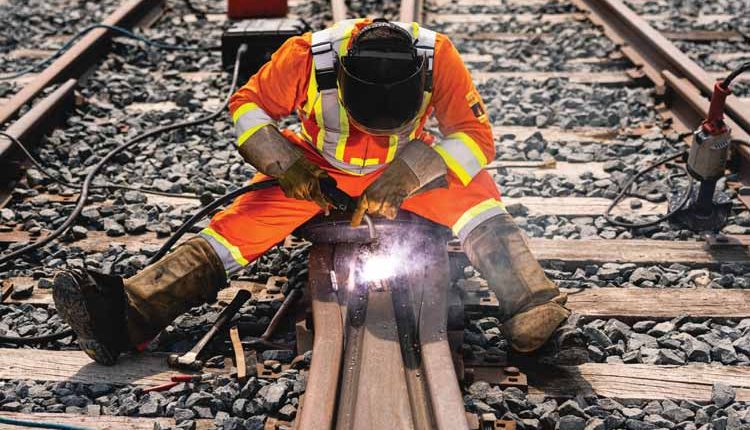Welding stands as a cornerstone within the railway industry, playing a critical role in both the maintenance and construction of railway tracks. Over time, traditional methods of joining rails, such as fishplates and bolts, have gradually yielded to welding due to its numerous advantages. Welded rail joints not only offer smoother passage for trains, thus reducing wear and tear, but also demand less maintenance compared to bolted joints.
Types of Welding
Flash Butt Welding
Flash Butt Welding emerges as a widely utilized method for joining rails within the railway sector. This technique harnesses electric current to generate the heat necessary for fusing rail ends, resulting in a strong and continuous joint crucial for maintaining the structural integrity of railway tracks.
The Process
The process unfolds with the preparation of rail ends, ensuring clean and precise cuts to facilitate a proper fit during welding. Subsequently, rail ends are meticulously aligned within specialized welding machinery to ensure perfect profile and positional matching. Following alignment, the rail ends are securely clamped within the welding machine, providing a stable and consistent position during the welding process. Electric current is then applied to the rail ends, inducing intense heat, causing them to reach a molten or plastic state. The forging process ensues, with the rail ends pressed against each other, resulting in a flash, indicative of the intense heat and pressure. This flash is followed by the upsetting process, where the ends are forcefully pushed together, eliminating impurities and forging a clean weld with a strong joint. Throughout, stringent control over parameters ensures a seamless joint. Post-welding procedures involve trimming excess material or flash and allowing the newly formed joint to cool gradually, essential for regaining strength and stability.
Post-Welding
Flash Butt Welding creates a continuous and robust joint significantly stronger than the rail itself, ensuring a smooth transition between rails, thus reducing wear and tear on train wheels and enhancing overall safety and longevity of railway tracks. This method necessitates skilled operators and high-precision equipment to achieve consistent and high-quality welds, crucial for safe and efficient railway operations. Advanced technology and strict quality control measures are employed to ensure welds meet necessary safety and durability standards.
Thermit Welding
Thermit welding, also known as Thermit fusion welding, stands as another widely adopted method within the railway industry for joining or repairing rails. This process utilizes a chemical reaction to produce molten steel, which then fills the gap between rail ends, creating a strong and durable joint.
Thermit Welding Process
The process commences with the cleaning and shaping of rail ends to ensure a proper fit and removal of any impurities or contaminants. A mold is then assembled around the rail ends to contain the molten metal. A pre-measured amount of Thermit mixture, typically comprising iron oxide and aluminum powder, is placed into a crucible within the mold. Ignition of an ignition source, such as a magnesium strip, initiates the chemical reaction between components of the Thermit mixture. This exothermic reaction yields extremely high temperatures, melting the Thermit charge and generating molten steel. The molten steel flows into the cavity between rail ends, filling any gaps and forming a weld upon solidification. Post-welding involves allowing the welded joint to cool naturally, followed by trimming excess material resulting from the welding process and finishing the surface to ensure a smooth and uniform rail profile. Thermit welding creates a high-strength, high-quality joint resistant to wear and tear, contributing to the longevity of railway tracks. Its versatility allows for both joining rails and repairing sections of rail.
Innovations and Future Prospects
Recent advancements in Thermit welding include improvements in the Thermit mixture to enhance the quality and efficiency of the process. Innovations in welding equipment and techniques continue to improve precision and reliability. Thermit welding remains an essential method for rail jointing and repairs due to its strength, durability, and reliability, ensuring safe and efficient operation of railway tracks. Proper execution and adherence to safety standards are critical for achieving high-quality welds.
Welding of Wagons & Rail Coaches
The manufacturing of railway wagons and the joining of railway coaches involve a series of processes encompassing various manufacturing techniques, materials, and assembly methods. These processes, from conceptualization and engineering to finishing and testing, require skilled labor, adherence to safety standards, and high-quality control measures to ensure the reliability and safety of railway operations. Ongoing technological advancements play a significant role in improving the efficiency, safety, and performance of railway rolling stock.
Welding in Locomotive Manufacture
The manufacture of locomotives necessitates various welding processes to fabricate, assemble, and join different components, crucial for creating a robust, durable, and reliable structure. Shielded Metal Arc Welding (SMAW), Gas Metal Arc Welding (GMAW), Gas Tungsten Arc Welding (GTAW), Flux-Cored Arc Welding (FCAW), and Submerged Arc Welding (SAW) are among the welding methods employed, each catering to specific materials, thicknesses, and structural requirements. These processes play a pivotal role in ensuring the structural integrity, reliability, and safety of heavy-duty transportation vehicles.
Robotic Welding
Robotic welding has become increasingly prevalent in the railway industry due to its efficiency, precision, and consistency. These automated systems contribute significantly to the production, repair, and maintenance of railway components, enhancing productivity, safety, and quality control measures.
Maintenance Welding in Railway Workshops
Railway workshops perform various maintenance welding applications critical for ensuring the safety, durability, and efficient operation of railway components and infrastructure. These applications encompass a wide range of tasks, including track repairs, reinforcement of rail joints, repairs of wagons, coaches, and rolling stock components, as well as maintenance of railway infrastructure and signal systems. Maintenance welding is vital for ensuring the safety and operational efficiency of the railway system, promoting the longevity and reliability of the railway network.



